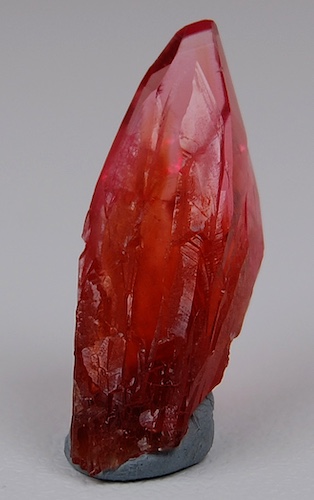RHODOCHROSITE
Introduction: Rhodochrosite is manganese carbonate (MnCO3). It forms a solid solution series with siderite (FeCO3) with iron substitution and with calcite (CaCo3) with calcium substitution. The name is from the Greek meaning “rose colored”. Rhodochrosite is often translucent to opaque, often in a variegated or banded pattern displaying shades of red, pink and white. This material is most commonly cut into spheres, beads, cabochons or carvings. The stalactitic forms are usually sliced into “bull’s eye” slabs. Far more rare are the transparent pink to orange-red crystals that are suitable for faceting.
Localities and Colors: Although not the focus of this page, Argentina is the main source of the massive and banded rhodochrosite. In 1974, South Africa, specifically the N’Chwaning mine in the Kalahari desert region became an important locality for transparent material. They form as single crystals (photo below) or in crystal clusters of elongated scalenohedra. The South African material is usually a medium-dark orange-red as pictured below right, in this 4.59 ct brilliant cushion. Rhodochrosite from Colorado was known as early as the late 1800’s, but it was not until the 1990’s that mining at the Sweet Home Mine in Alma produced much of the world’s finest rhodochrosite. Faceted stones are pink to reddish-pink similar to the 7.20 ct modified rectangle brilliant pictured below. The material from Colorado crystallizes in the more typical carbonate form of rhombs. In the early 2000’s, China became a source of rhodochrosite similar in color to the Colorado material but the locality was only productive for a brief time. Peru is a minor source of facetable material similar in color to the South African rhodochrosites. Quebec is also a minor source, much of the material having a brownish saturation to the orange-red hue. Most of the Canadian material is reserved for the collector market.



Clarity: Transparent faceted rhodochrosite is seldom flawless but is commonly eye clean although minor,
eye visible inclusions are acceptable if they do not interfere with the overall appearance of the stone.
Stone Sizes: There have been many large faceted rhodochrosites in the last 50 years or so, up to 60 carats for South African material and 92 carats from Colorado. Currently available gems are usually less than 5 carats.
Treatments: There are no known treatments for rhodochrosite. Due to the nature of the material, the possibility exists for some type of clarity enhancement with resins, oils or other fillers but to the best of my knowledge, this treatment has never been seen in a faceted gem.
Properties: Rhodochrosite has a hardness of 3.5-4 on the Mohs scale. It has three directions of cleavage and the toughness would be considered poor. With these properties, it would seem that rhodochrosite would not make an acceptable stone for use in jewelry. While rings would be discouraged, it actually wears well in pendants, earrings or brooches if proper care is taken. The refractive index is 1.597-1.817 with an incredibly high birefringence of 0.201-0.220. Higher amounts of calcium in the chemical formula will reduce the refractive index and birefringence while iron increases them. The high birefringence is the reason that some stones have a “sleepy” appearance. This extreme doubling can be eliminated by orienting the table perpendicular to the optic axis but this usually results in much lower yields. Due to the high cost of the material, it is not advisable. A property not often examined with gemstones is magnetism. Due to the manganese content, rhodochrosite is attracted to a rare earth magnet (as seen in the photo to the right) and becomes a quick way of separating a rhodochrosite from similarly colored red gemstones.
Availability: Well, now for the bad news! All of the world’s localities for transparent facetable rhodochrosite are no longer producing any material so any “new” stones on the market are either reworked from older poorly cut or damaged stones or cut from broken crystals from old collections or inventories. Although it is still possible to find rhodochrosite for use in jewelry, the collector market has swallowed up many of the larger, finer stones. Fine, well formed, undamaged rhodochrosite whether as single crystals, crystal clusters or matrix specimens are extremely rare and priced well above the level at which the cut stones would be worth.